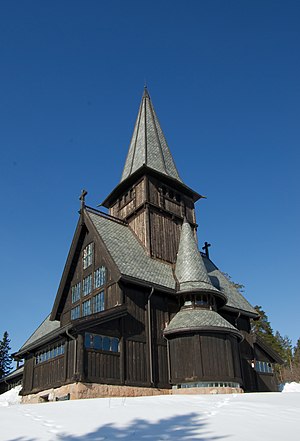Holmenkollen Chapel
| Holmenkollen Chapel | |
|---|---|
| Holmenkollen kapell | |
 |
|
| 59°57′56.39″N 10°40′20.38″E / 59.9656639°N 10.6723278°ECoordinates: 59°57′56.39″N 10°40′20.38″E / 59.9656639°N 10.6723278°E | |
| Location |
Holmenkollen, Oslo, |
| Country | Norway |
| Denomination |
|
| Churchmanship | Evangelical Lutheran |
| Website | www.oslo.kirken.no/ris/holmenkollen |
| History | |
| Consecrated | 1996 |
| Architecture | |
| Status | Chapel |
| Functional status | Active |
| Style | Dragestil |
| Specifications | |
| Capacity | 200 |
| Materials | Wood |
| Administration | |
| Parish | Ris |
| Diocese | Diocese of Oslo |
Holmenkollen Chapel is located at Holmenkollen in Oslo, Norway. The original chapel from 1903 was destroyed by fire in 1992. The new chapel was completed in 1996. Holmenkollen Chapel is a listed site, registered in Norway's cultural heritage database.
Holmenkollen Chapel was first built in 1903 after designs by architect Peter Andreas Holger Sinding-Larsen as a paneled wooden pole construction.
"Holmen og Voxenselskabet" was founded in 1880 for the acquisition and development of the area as a recreational area for locals. When the company disbanded in 1890, it gave one of its plots of ca. 10,000 m² to Oslo municipality to build a sports chapel.
Closely related to Holmenkollen Chapel was Fortidsminneforeningen. This association was established in 1844 with several painters as initiators. It was primarily the painter Johan Christian Dahl who spoke in favour of a stave church. The association was the birthplace of a young generation of Norwegian architects around the turn of the 20th century, reviving the tradition of Norwegian wooden architecture. They searched back to the early Middle Ages, when Norway had its Golden Age. They emphasized identity and their own history, nature and architecture. Holmenkollen Chapel was a direct result of the young generation of architects' emerging awareness of this heritage.
From its opening in 1903, the building was used as a chapel. Only in 1913 was it dedicated to the use of church services and church ceremonies such as baptism, confirmation, marriage and funerals in addition to sports services. The chapel was intended as a facility for hikers who wanted to attend a Sunday service, even if they chose to go up into the heights for exercise and fresh air. Hiking in the woods was almost fashionable in the late 19th century.
...
Wikipedia
